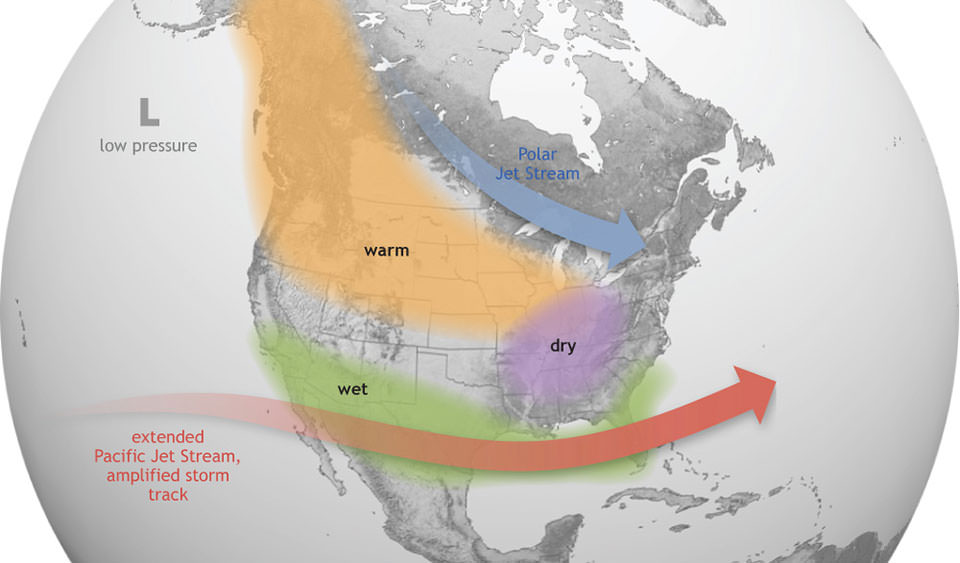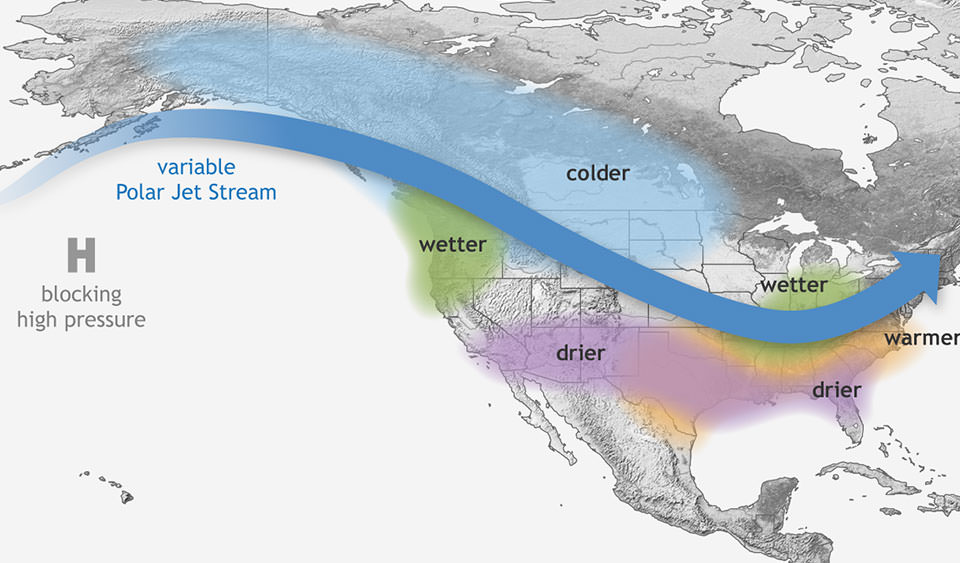
El Niño is a naturally occurring phenomenon of periodic warming of sea surface temperatures in the central and eastern regions of the Pacific Ocean. La Niña is the opposite, describing cooler-than-average sea temperatures. Both El Niño and La Niña significantly affect Earth's weather patterns.
El Niño and La Niña events occur every two to seven years on average and usually last between nine to 12 months, but can sometimes persist for years. According to the National Oceanic and Atmospheric Administration (NOAA), El Niño generally occurs more frequently than La Niña.
An El Niño is declared when sea temperatures in the tropical eastern Pacific rise 0.5 degrees Celsius (32.9 degrees Fahrenheit) above the long-term average, says the national meteorological service for the U.K., the Met Office.
Related: Climate change: Causes and effects
Is there an El Niño this year?
According to scientists, we are currently experiencing El Niño conditions.
The ocean-warming event was announced in a statement by the National Oceanic and Atmospheric Administration (NOAA) on June 8, 2023. Forecasters issued an El Nino Advisory, noting that El Nino conditions are present. If they continue through October, then it will be confirmed as an El Niño event.
"Depending on its strength, El Niño can cause a range of impacts, such as increasing the risk of heavy rainfall and droughts in certain locations around the world," Michelle L'Heureux, a physical scientist at NOAA's Climate Prediction Center, said in NOAA's announcement statement. "El Niño could lead to new records for temperatures, particularly in areas that already experience above-average temperatures during El Niño."
What do El Niño and La Niña mean?
El Niño translates to "the boy" in Spanish. The term is thought to have originated in the 1600s when fishermen first started to notice unusually warm water in the Pacific Ocean. It originated as "El Niño de Navidad" because it typically peaks around December, according to NOAA (Navidad is Spanish for "Christmas."). La Niña means little girl in Spanish, it has the opposite effect of El Niño and is sometimes referred to as El Viejo, anti- El Niño or "a cold event."
What happens during El Niño and La Niña?
Under normal circumstances, permanent east-to-west winds known as trade winds blow westward along the equator in the Pacific Ocean, moving warm water from South America toward Asia, according to NOAA. The warm water is replaced by nutrient-rich cold water rising from the deep ocean in a process known as upwelling. The burst of nutrients from the depth drives seaweed growth and supports vast blooms of phytoplankton — microscopic organisms — which are a crucial energy source for large animal populations. As such, coastal upwelling regions are some of the most productive ecosystems in the world, supporting important fisheries.
However, two opposing climate patterns, El Niño and La Niña disrupt these normal conditions. Scientists refer to these phenomena collectively as the El Niño-Southern Oscillation (ENSO) cycle.
During El Niño, the strength of trade winds diminishes, causing warm water to be redirected eastward, towards the western coastlines of the Americas and the upwelling of cold water diminishes.
But during La Niña, trade winds intensify, resulting in a greater push of warm water towards Asia. Simultaneously, off the coast of the Americas, upwelling increases, causing more cold nutrient-rich water to rise to the surface.
The exact cause of El Niño and La Niña remains unknown.
What are the effects of El Niño?

El Niño has a substantial impact on our weather patterns as elevated ocean temperatures cause the Pacific jet stream to shift southward from its normal position.
As a result, regions in the northern United States and Canada experience drier and warmer conditions than usual. Conversely, the U.S. Gulf Coast and Southeast encounter above-average rainfall during these periods, leading to increased instances of flooding, according to NOAA.
The effects of El Niño are also felt in marine populations. During El Niño, upwelling of cold nutrient-rich water weakens or ceases entirely, resulting in reduced phytoplankton. This leads to a scarcity of food for the fish populations that rely on phytoplankton as a primary food source. Consequently, the impact trickles up the food chain to other organisms dependent on fish such as seabirds and marine mammals.
In India, the occurrence of El Niño is commonly linked to the influence it exerts on the monsoon season, resulting in below-average rainfall and contributing to severe droughts, as witnessed in seven instances between 2001 and 2020. Four of those years were marked by drought conditions and a decline in summer crop production, according to the Indian news site The Economic Times.
During winters influenced by El Niño, northern Europe experiences colder and drier conditions, while southern Europe receives increased rainfall due to the shifting of the jet stream. Conversely, in the U.K., El Niño summers tend to be hotter and drier, according to the Met Office.
What are the effects of La Niña?

During La Niña the presence of cold waters in the Pacific Ocean results in a northward shift of the jet stream. This shift often leads to dry conditions in the southern United States while causing increased rainfall and flooding in the Pacific Northwest and Canada.
During La Niña years, winter temperatures tend to be warmer than usual in the southern regions and cooler in the northern areas. Additionally, La Niña can contribute to the heightened intensity of the hurricane season.
With the increased upwelling during La Niña, marine ecosystems benefit from a flurry of nutrients from the depth. The colder waters off the Pacific coast also attract more cold-water species such as squid and salmon to the Californian coast.
In India, the presence of La Niña can result in heightened rainfall and a significantly stronger monsoon season. According to the Met Office, summers in the UK typically exhibit a greater tendency towards wetter conditions.
El Niño FAQs answered by an expert
We asked Aaron Levine, a postdoctoral research associate at NOAA's Pacific Marine and Environmental Laboratory in Seattle a few commonly asked questions about El Niño.
What is El Niño?
El Niño is an anomalous warming of the Eastern Equatorial Pacific Ocean, typically covering much of the area from the South American coast to west of the dateline. An eastward shift in where the tropical precipitation forms over the Pacific, known as the Southern Oscillation also happens. The opposite is La Niña, when anomalously cold waters occur in the Eastern Equatorial Pacific Ocean and there is a westward shift of precipitation. Collectively, these are the phenomenon known as El Niño-Southern Oscillation (ENSO).
Has El Niño 2023 arrived?
NOAA has issued an El Niño Advisory meaning that El Niño conditions are currently occurring and expected to continue. For this to be an El Niño event, these conditions will have to persist through October. Other national weather services have slightly different criteria but generally agree that if the current conditions persist or intensify, there will be an El Niño event.
How long does El Niño last?
El Niño events typically last approximately 9 months. El Niño events typically form during the northern hemisphere summer or fall, peak during the winter, and end during the spring. Strong El Niño events frequently end suddenly and quickly transition to La Niña.
How often do we experience El Niño?
El Niño events typically occur every 2-7 years. The last El Niño event was the winter of 2018-2019.
Does El Niño cause more rain?
El Niño increases the likelihood of wetter conditions in some areas and drier conditions in others across the globe. It is important to also recognize that just because an El Niño event occurs does not mean that these conditions will definitely occur in any location. Here are good maps of typical El Niño impacts and La Niña impacts.
Does climate change affect El Niño?
We expect that climate change will impact El Niño but there is currently little agreement in how El Niño will change due to climate change.
Additional resources
Learn more about El Niño and La Niña with these helpful resources from NOAA Climate. Discover how El Niño affects wildlife with this article from BBC Wildlife Magazine. For further information on El Niño check out these resources from National Geographic.
Bibliography
Birewar, D. (2023). How El Nino may impact agriculture and monsoon this year? The Economic Times. [online] 6 Jun. Available at: https://economictimes.indiatimes.com/news/how-to/how-el-nino-may-impact-agriculture-and-monsoon-this-year/articleshow/100787045.cms [Accessed 29 Jun. 2023].
Gaines, S. and Airame, S. (n.d.). NOAA Ocean Explorer: Sanctuary Quest: Background. [online] oceanexplorer.noaa.gov. Available at: https://oceanexplorer.noaa.gov/explorations/02quest/background/upwelling/upwelling.html
Lakes of India. (2023). La Nina and El Nino Effect in India. [online] Available at: https://lakesofindia.com/2023/01/16/la-nina-and-el-nino-effect-in-india / [Accessed 29 Jun. 2023].
Met Office (n.d.). What are El Niño and La Niña? [online] Met Office. Available at: https://www.metoffice.gov.uk/weather/learn-about/weather/oceans/el-nino
Met Office. (n.d.). El Niño Southern Oscillation (ENSO) region sea surface temperature forecasts. [online] Available at: https://www.metoffice.gov.uk/research/climate/seasonal-to-decadal/gpc-outlooks/el-nino-la-nina[Accessed 29 Jun. 2023].
www.weather.gov. (2023). NOAA declares the arrival of El Nino. [online] Available at: https://www.weather.gov/news/230706-ElNino.







